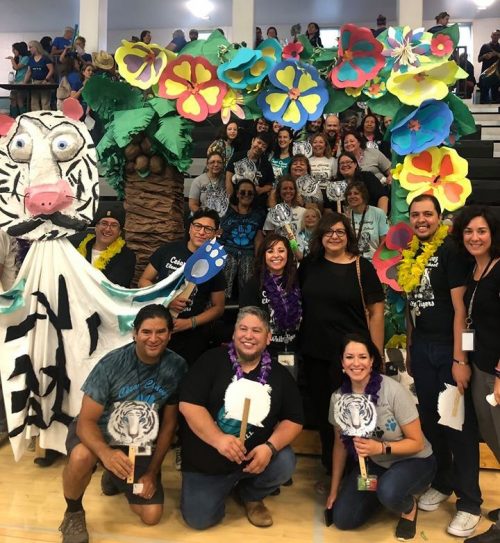What Happens When You Foster a Culture of Love
As a part of our series on the social determinants of education, here is a story from a Santa Fe elementary school that is working to heal adverse childhood experiences by using a simple and powerful framework: love. Their approach is even more important and relevant during COVID-19 closures.
The news of the district closing came fast, catching us all by surprise. It was the Friday before spring break, and my team and I scrambled to get our devices out. We made sure every student had mine and the Assistant Principal’s contact information so that we can be easily reached if any of our students needed us.
I knew the impact this would have on our students when I went into a 5th grade class, and a student said, “Ms. Amanda this isn’t fair, we aren’t going to have enough time with you.” I ran out of the room and broke out into tears. Our school has become a safe haven to our students. We have become a family, a family of support and love. In that instant our school team made it a priority to continue the support and love we had built remotely.
Immediately, we made sure our Wellness Team was up and running. We created a new email where families could easily access our team for support. It was also a priority to make sure we continued engaging families, we planned virtual evenings which included an open house, family cooking night, a pet parade, and end-of-year ceremonies. We wanted to stress that our families and our community were still our priority. We continued our tutoring efforts, and collaboration with our community partners. What COVID-19 showed us is that our community needed us now more than ever, and to us remote learning meant more effort, more support.
How We Built This
When I walked into my first “Wellness Meeting” at César Chávez Elementary School, I expected it to be just that, a meeting. But as I listened and collaborated, a connection was made that would define me as a leader forever.
Hired as the new Assistant Principal at César Chávez in 2017, I quickly discovered an abundance of amazing things apparent about the school. Diversity, multiculturalism, and bilingualism were not only strived for but celebrated. The staff knew every student, and was well versed in that student’s background both at school and at home. Among the many responsibilities my principal assigned me, it quickly became clear Wellness Meetings were one of the most important.
What Was Missing
In the meeting, I was excited to be collaborating with the staff involved in wellness, which included our veteran nurse, community coordinator, and our school counselor. These three women were the experts, and my role that first meeting was mostly to listen.
We discussed a long list of students, students who were under our roof, with challenges that many of us could never imagine living through. These children—our children—walked our halls carrying unimaginable weight. We were doing what educators are supposed to do: asking them for proficiency, focus, appropriate behavior, work completion, and self-regulation. But as a team we realized something was missing. We realized that before these requests and expectations, we need to prioritize student wellness.
So we decided to take a leap. We threw ourselves into understanding childhood trauma and adverse childhood experiences. We decided to start by laying a foundation of love.
The Transformation
The next year I was promoted to Principal at César Chávez, a school that had become a home to me. My team and I had decided that this year we would make love our priority, and would attempt to solidify all staff's understanding on childhood trauma.
We opened up the year with this expectation and shared it with our staff: the expectation that we will give every child that walked into our doors what they deserved, which included, but was not limited to, love, happiness, wellness, and success.
Many of the staff believed they were already doing just that. They put in countless hours providing students what they deserve: tools for a successful future. But our idea was to make this more intentional by mindfully focusing on the whole child. Some of the expectations set forth were to never deny a child a hug, to never be too busy to listen to what they had to say, and to make decisions that were centered around what they deserved. This included every decision made by every staff member. We talked a lot about student wellness, and before decisions were made about discipline we would stop and ask ourselves what that child was carrying on their shoulders. We searched for what their behavior was telling us about what they needed.
This all seemed simple, but many staff had a hard time wrapping their minds around this new foundation. Many teachers looked at the very hard work they were already putting in, and felt they were already heading in this direction. One pivotal event clarified why we were insisting on a culture of love. One event made us realize that this change, this movement, wasn’t only the right choice, but also was the necessary choice.

""
A Pivotal Moment
It was September, and we had already run into speed bumps with this new movement toward whole-child, trauma-informed teaching. It was hard to convince all stakeholders involved what we were trying to do, and why it was important. I was talking to a group who was visiting our school when I was suddenly called to the office for an emergency, (which happens quite often as an administrator). The emergency was nothing I expected and would change the lives of everyone in our building.
We had lost a kindergarten student. One of our babies had been murdered, lost to child abuse. Looking back, I think this student became the driving force behind all we do. His loss shined light on why our new expectations and purpose were so necessary. He opened our eyes to the need to put up a fight against childhood trauma.
Suddenly every staff member viewed our students with a different lens. They saw that students were beyond deserving, they saw that if students were loved and truly seen, students could be saved.
What’s Next
This is my second year as principal. Our culture of love not only exists but is thriving. We are becoming a trauma-informed community school, so that our love is not only contained to those within our school, but can be spread throughout our community.
In our journey we often refer to Anna, Age Eight by Katherine Ortega Courtney and Dominic Cappello. This book illustrates that one positive individual can have a significant impact on childhood trauma. The beauty at César Chávez is we have a whole school of these individuals.
Typically school success is measured by student proficiency in reading and math. But without a culture that is best for students, which is one that supports the whole child, proficiency will not last. We are still labeled as an underperforming school; but we are making small gains every day. What I know now and see daily, is a staff who don’t view their work as a job, but as their mission in life. We have students who, when asked about their school, answer how loved they are. We have a community that rests easy because they know our support is not contained within our walls, but is extended to all who have a hand in raising our children.
We are a school on the rise because our roots have been watered with love.




Comments
That is amazing. I will quote you in my paper.
I wish more schools would take the time and effort you and your staff are putting forth for these students. I know we are all busy but these children are our future❣️❣️ We have to take care of them and let them know that somebody cares. Because sometimes they get shoved under the carpet at home and they don’t have anyone and we both know where that leads. So Thank You again. God Bless You and your staff.